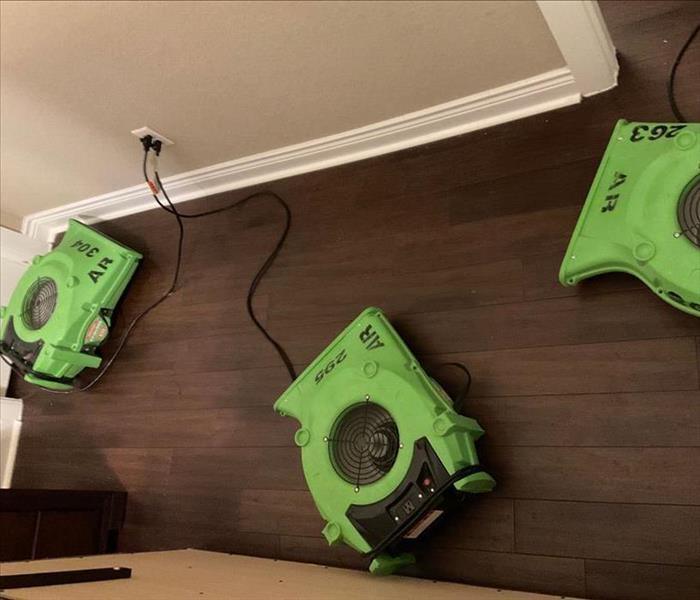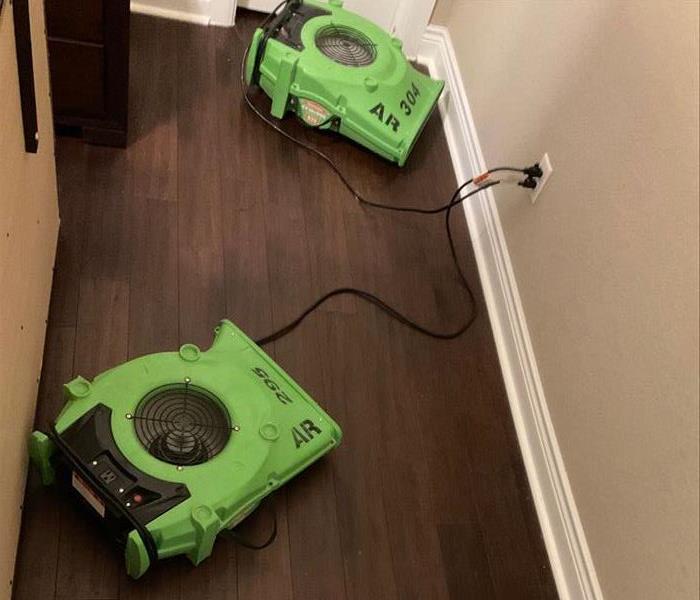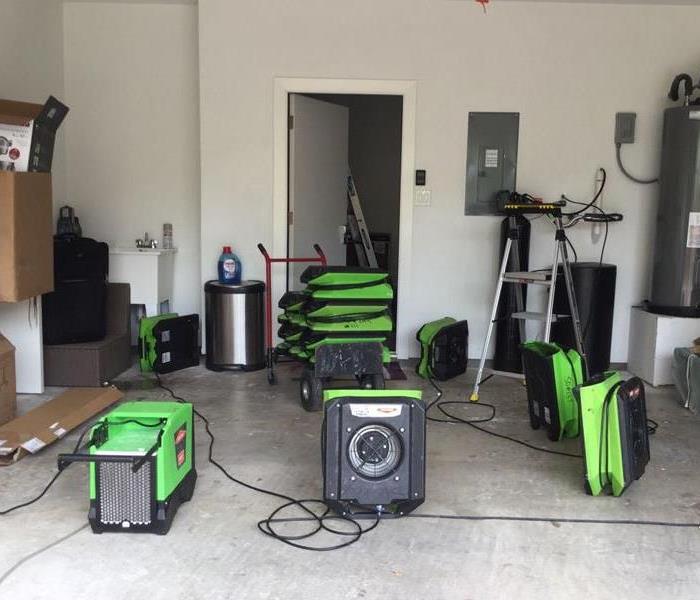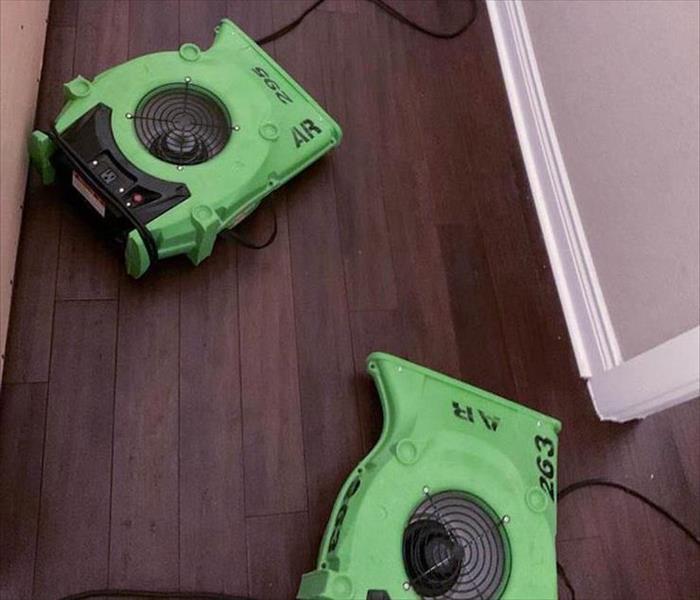Recent Posts
How to Clean Up Small Amounts of Mold in Your House
7/10/2024 (Permalink)
Discovering mold in your home, no matter how small the amount, can be unsettling. However, addressing mold promptly can prevent it from spreading and causing further damage. While large mold infestations may require professional remediation, small areas of mold can often be cleaned up safely with the right approach. In this blog, we'll explore how to clean up small amounts of mold in your house effectively.
Safety First
Before you begin cleaning up mold, it's essential to prioritize safety. Wear protective gear, including gloves, a mask, and goggles, to prevent exposure to mold spores and potential irritants.
Identify the Affected Area
Locate the area of mold growth in your home. Common areas include bathrooms, kitchens, basements, and areas with water damage or poor ventilation.
Gather Your Supplies
You'll need the following supplies to clean up small amounts of mold:
- Protective gear (gloves, mask, goggles)
- A scrub brush or sponge
- A bucket
- Mild detergent or soap
- Water
- A spray bottle
- Vinegar or hydrogen peroxide (optional)
- A clean towel or rag
Prepare the Area
Open windows and doors to ventilate the area and improve airflow. This helps prevent the spread of mold spores to other areas of your home.
Mix Cleaning Solution
In a bucket, mix a small amount of mild detergent or soap with water to create a cleaning solution. Alternatively, you can use a solution of vinegar or hydrogen peroxide diluted with water for natural cleaning.
Dip a scrub brush or sponge into the cleaning solution and scrub the moldy area gently but thoroughly. Focus on removing visible mold growth and any stains or discoloration on surfaces.
Rinse and Dry
After scrubbing, rinse the area with clean water to remove any remaining soap or cleaning solution. Use a clean towel or rag to dry the area thoroughly. Proper drying is essential to prevent moisture buildup and inhibit future mold growth.
Dispose of any materials used during the cleaning process, such as gloves, sponges, and towels, in a sealed plastic bag to prevent the spread of mold spores.
Monitor for Recurrence
Keep an eye on the cleaned area for signs of mold recurrence. If mold returns or persists despite cleaning, it may indicate underlying moisture issues that need to be addressed.
Address Underlying Causes
To prevent mold from returning, identify and address the underlying causes of moisture or humidity in your home. This may include fixing leaks, improving ventilation, and reducing humidity levels.
Cleaning up small amounts of mold in your house is manageable with the right approach and precautions. By following these steps and addressing underlying moisture issues, you can effectively remove mold and create a healthier indoor environment for you and your family. However, if you're dealing with a large mold infestation or persistent mold growth, it's best to consult a professional like SERVPRO of Stone Oak for thorough remediation and prevention measures.
The Role of Thermal Imaging in Detecting Hidden Water Damage
6/12/2024 (Permalink)
 Trust SERVPRO to leverage the latest innovations in restoration technology, ensuring prompt, professional, and reliable service every step of the way.
Trust SERVPRO to leverage the latest innovations in restoration technology, ensuring prompt, professional, and reliable service every step of the way.
As your trusted restoration experts, we at SERVPRO® understand that water damage can often be more than meets the eye. While some signs may be apparent, such as damp spots or discoloration on walls and ceilings, there are instances where water damage lurks beneath the surface, undetectable to the naked eye. This is where thermal imaging proves to be an invaluable tool in our arsenal.
What is Thermal Imaging?
Thermal imaging, also known as infrared thermography, is a technology that allows us to capture images of heat radiation emitted by objects and surfaces. By using specialized cameras, we can visualize temperature variations within a given space, revealing anomalies that may indicate the presence of hidden water damage.
Detecting Hidden Water Damage
Water has a distinct thermal conductivity compared to dry materials like wood or drywall. When moisture is present, it alters the temperature of the affected area, creating thermal patterns that can be identified through thermal imaging. Even if water is concealed behind walls, ceilings, or floors, thermal imaging can detect these subtle temperature variations, enabling us to pinpoint the source of the problem accurately.
Preventing Further Damage
Identifying hidden water damage early is crucial in preventing further structural deterioration and mold growth. By utilizing thermal imaging during our inspection process, we can intervene promptly, mitigating potential risks and minimizing the scope of damage. This proactive approach not only safeguards your property but also helps to avoid costly repairs down the line.
Enhanced Efficiency and Accuracy
Traditional methods of detecting water damage, such as visual inspection or moisture meters, may overlook hidden issues or require invasive techniques like drilling holes for access. Thermal imaging offers a non-invasive, efficient alternative that provides comprehensive insights without causing disruption to your property. By accurately identifying the extent of water damage, we can develop a targeted restoration plan tailored to your specific needs, ensuring swift and effective resolution.
Trusted Expertise, Reliable Solutions
At SERVPRO, we prioritize the use of advanced technologies like thermal imaging to deliver superior results for our clients. Our certified technicians undergo rigorous training to proficiently utilize these tools, combining technical expertise with industry-leading practices to address even the most challenging water damage scenarios.
When it comes to safeguarding your property against the perils of water damage, knowledge is power. By harnessing the capabilities of thermal imaging, we can uncover hidden issues before they escalate, providing peace of mind and preserving the integrity of your home or business. Trust SERVPRO to leverage the latest innovations in restoration technology, ensuring prompt, professional, and reliable service every step of the way. Contact us today to learn more about how thermal imaging can benefit your property.
Protecting Your Business from Storm-Related Disruptions
5/15/2024 (Permalink)
As a business owner, you're likely aware of the myriad of challenges that can arise unexpectedly. One of the most disruptive forces to any business operation is severe weather. From hurricanes to blizzards, storms can wreak havoc on your daily operations, leading to significant financial losses if not handled properly. At SERVPRO®, we understand the importance of proactive measures to safeguard your business from storm-related disruptions. Here are some essential tips to help you weather the storm and keep your business running smoothly.
Develop a Comprehensive Emergency Plan
Prepare for the worst by creating a detailed emergency plan that outlines procedures for staff, communication protocols, and evacuation routes. Assign specific roles and responsibilities to key personnel to ensure a coordinated response in the event of a storm.
Secure Your Property
Conduct a thorough assessment of your property to identify potential vulnerabilities. Secure loose objects, such as outdoor furniture and signage, to prevent them from becoming projectiles in high winds. Reinforce windows and doors to minimize the risk of damage from flying debris.
Backup Important Data
Protect your business's vital information by regularly backing up data to off-site servers or cloud-based storage solutions. This ensures that critical documents and records are safe from physical damage caused by flooding or power outages.
Invest in Flood Protection
If your business is located in a flood-prone area, invest in flood protection measures such as sandbags, flood barriers, and sump pumps. Consider elevating equipment and electrical systems to minimize damage in the event of water intrusion.
Partner with a Professional Restoration Company
Establish a relationship with a reputable restoration company like SERVPRO to provide prompt and efficient cleanup and restoration services in the aftermath of a storm. Having a trusted partner on standby can significantly reduce downtime and mitigate losses.
Stay Informed
Monitor weather forecasts and stay informed about impending storms to give yourself ample time to prepare. Sign up for local alerts and notifications to receive timely updates and advisories from emergency management agencies.
Conduct Regular Maintenance
Stay proactive with routine maintenance of your property's exterior, including roofs, gutters, and drainage systems. Clear debris from gutters and downspouts to ensure proper water flow away from your building.
By taking proactive measures to protect your business from storm-related disruptions, you can minimize downtime, reduce financial losses, and ensure the safety of your employees and customers. Remember, preparation is key to weathering the storm and emerging stronger on the other side. At SERVPRO, we're here to support you every step of the way. Contact us today to learn more about our comprehensive storm damage restoration services. Stay safe, stay prepared, and let's weather the storm together!
How to assess the extent of fire damage in your home
4/9/2024 (Permalink)
Experiencing a fire in your home can be a devastating event, leaving you feeling overwhelmed and unsure of where to start in the recovery process. At SERVPRO®, we understand the importance of taking immediate action and assessing the extent of fire damage to begin the restoration process promptly. In this blog post, we'll guide you through a step-by-step process to help you evaluate the aftermath of a fire and understand the severity of the damage.
Safety First
Before entering your home, ensure that it is safe to do so. Always wait for the go-ahead from the fire department or other relevant authorities. Once you have clearance, wear protective gear, including gloves and a mask, to safeguard yourself from potential hazards such as smoke residue and soot.
Evaluate Structural Damage
Begin by assessing the structural integrity of your home. Check for visible signs of damage, including sagging ceilings, cracks in the walls, or compromised support beams. If you notice any significant structural issues, it's crucial to consult with a professional before re-entering the premises.
Inspect the Interior
Survey each room thoroughly to identify the extent of damage. Look for areas where the fire was most intense, noting the level of destruction. Pay close attention to walls, ceilings, and floors, as well as the condition of personal belongings and furniture. Documenting the damage through photographs can be beneficial for insurance claims.
Examine Electrical and Plumbing Systems
Inspect electrical outlets, wiring, and plumbing systems for any visible damage. Fire can compromise these systems, posing additional risks. If you notice any issues, contact a qualified professional to assess and repair the damage.
Assess Water Damage
Firefighting efforts often involve water, leading to potential water damage in addition to fire damage. Check for waterlogged areas, including ceilings, walls, and flooring. Addressing water damage promptly is crucial to prevent mold growth and further structural issues.
Soot and Smoke Residue
Evaluate the presence of soot and smoke residue on surfaces. Different materials produce varying types of residue, and understanding this can help in choosing the appropriate cleaning methods. In some cases, professional cleaning services may be necessary to ensure thorough removal.
Assessing the extent of fire damage in your home is a critical first step towards recovery. While this guide provides a general overview, it's essential to consult with professionals like SERVPRO to develop a comprehensive restoration plan tailored to your specific situation. Remember, acting swiftly and systematically will pave the way for a successful recovery and the restoration of your home to its pre-fire condition.
Mold and High Humidity Climates: Prevention Strategies
3/18/2024 (Permalink)
 In this blog, we will explore tips and strategies to prevent mold damage in high-humidity climates.
In this blog, we will explore tips and strategies to prevent mold damage in high-humidity climates.
High-humidity climates provide the perfect conditions for mold growth. Mold damage in homes located in these areas can be a common occurrence if proper preventive measures are not taken. It is essential to be proactive in preventing mold growth to avoid potential mold damage and the need for mold remediation. In this blog, we will explore tips and strategies to prevent mold damage in high-humidity climates.
Understanding Mold Growth in High Humidity Climates
High-humidity climates create an environment where excess moisture is present, providing the ideal conditions for mold growth. Mold spores are naturally present in the air, and when combined with moisture, they can quickly colonize and cause mold damage to various surfaces in your home. Common areas where mold is found in high-humidity climates include basements, bathrooms, kitchens, and other areas prone to moisture accumulation.
Prevention Strategies for Mold in High Humidity Climates
Preventing mold damage in high-humidity climates requires diligent moisture control. Here are some prevention strategies to consider:
- Invest in a Dehumidifier: High-quality dehumidifiers help reduce moisture levels in your home, creating an unfavorable environment for mold growth. Consider placing dehumidifiers in areas prone to humidity, such as basements or bathrooms.
- Ensure Proper Ventilation: Proper ventilation is essential in high-humidity climates as it helps maintain optimal airflow and expels excess moisture. Use exhaust fans in bathrooms, kitchens, and laundry rooms to minimize moisture accumulation.
- Seal Potential Entry Points: Inspect your home for any potential entry points for moisture. Seal gaps and cracks in windows, doors, and walls to prevent moisture infiltration.
- Control Condensation: Condensation can contribute to mold growth. Insulate cold surfaces such as pipes, windows, and walls to prevent condensation formation. Use insulation with a vapor barrier to reduce moisture buildup.
- Monitor Indoor Humidity Levels: Invest in a hygrometer to monitor indoor humidity levels. Ideally, humidity should be kept below 50 percent. If necessary, adjust your dehumidifier settings accordingly.
- Proper Maintenance: Regularly inspect and maintain areas prone to mold growth. Keep an eye on neglected areas such as crawl spaces and attics, ensuring proper insulation and ventilation.
- Promptly Address Water Damage: In the event of water damage, act quickly to dry affected areas thoroughly. Use fans, dehumidifiers, and towels to remove moisture promptly and mitigate the risk of mold growth.
- Regular Cleaning: Regularly clean and maintain surfaces prone to mold, such as bathrooms and kitchens. Use mold-inhibiting cleaners to prevent mold growth in these areas.
Professional Mold Prevention and Remediation Services
In high-humidity climates, it is advisable to seek professional mold prevention services. Professional mold remediation experts have the knowledge and experience to assess your home's specific needs and develop a comprehensive mold prevention plan. Their expertise can help mitigate mold damage risks and ensure a mold-free environment.
Preventing mold damage in high-humidity climates requires proactive moisture control and proper maintenance. By investing in dehumidifiers, promoting proper ventilation, sealing potential entry points, controlling condensation, monitoring indoor humidity levels, addressing water damage promptly, and regularly cleaning and maintaining mold-prone surfaces, you can significantly reduce the risk of mold growth. Consider seeking professional mold prevention and remediation services for comprehensive mold prevention strategies. By implementing these prevention strategies, you can protect your home and maintain a mold-free living environment.
How to Protect Your Business from Storm-Related Disruptions
1/17/2024 (Permalink)
 After a storm has hit, swift action is necessary to prevent further damage.
After a storm has hit, swift action is necessary to prevent further damage.
Storms don't just disrupt the tranquility of our homes; they disrupt our businesses as well. Protecting your business against storm-related disruptions is crucial to ensure minimal downtime and protect your livelihood. At SERVPRO of Stone Oak, we're not just your go-to specialists for storm damage cleanup and restoration – we're also committed to providing you with preventive measures. Here's how you can protect your business from storm-related disruptions.
1. Establish an Emergency Plan
By developing an emergency response plan, you can ensure that your business operations can continue amid disruptions. This plan should include emergency contact numbers, evacuation routes, and business continuity procedures.
2. Secure and Backup Important Data
Digitize and back up all essential documents and data using a cloud service. This safeguard ensures that critical information isn't lost in the event of water damage or power outages.
3. Inspect Your Building Regularly
Regular property inspections, especially before the storm season arrives, can protect your building from potentially catastrophic damage. Heed particular attention to your roof, drainage systems, and exterior sealants.
4. Invest in a Commercial-Sized Generator
Persistent power outages can significantly impact your business. A generator will keep critical systems operational and prevent data loss during power outages.
5. Protect Your Assets
Safeguard valuable equipment and inventory by moving them to higher, protected areas of the building if flood risk is high. Additionally, invest in quality insurance that covers storm-related damage.
6. Maintain Clear Communication
Ensure your employees are well informed about the emergency protocol. Maintaining clear channels of communication can lead to efficient evacuation or safe shelter during a storm.
7. Install Surge Protectors
Lightning strikes during storms can cause power surges, potentially damaging vital electronics. Surge protectors can safeguard your computers, point-of-sale systems, and other critical electronic devices.
8. Hire Professional Cleanup Services
After a storm has hit, swift action is necessary to prevent further damage. Professional cleanup and restoration companies like SERVPRO of Stone Oak can mitigate damage, handle insurance claims, and get your business up and running as quickly as possible.
Taking these preemptive measures can significantly reduce downtime and protect your business during stormy weather. However, no amount of planning can make your business completely invincible to severe weather. If storm damage occurs, call on our SERVPRO® team for speedy cleanup and restoration – we work to make it "Like it never even happened."
Lightning Safety: Protecting Your Home from Fire Hazards
12/15/2023 (Permalink)
Lightning is a powerful force of nature, and it can have devastating consequences if it strikes your home. But with some proactive measures and knowledge, you can significantly reduce the risk. Let's dive into some important tips to keep your home safe.
Install a Lightning Protection System
A lightning protection system, commonly known as a lightning rod, is an effective way to safeguard your home against lightning strikes. It works by providing a safe path for the electrical discharge from a lightning strike to reach the ground without causing harm to your home. When properly installed, lightning rods can dissipate the electrical charge, reducing the risk of a fire starting from a strike.
Surge Protection
Lightning strikes can cause power surges that may damage electronic devices and even start fires. To protect your home's electrical systems and appliances, install surge protectors at key points throughout your house. These devices are designed to absorb and divert excess electrical energy, preventing damage from power surges.
Maintain Your Roof
A well-maintained roof is your first line of defense against lightning strikes. Ensure your roof is in good condition and free from any vulnerabilities like loose shingles, damaged chimneys, or holes.
Grounding Your Home
Proper grounding is essential to protect your home from lightning strikes. Grounding systems divert electrical energy safely into the ground. To ensure your home is properly grounded, it's recommended to consult with a professional electrician or lightning protection specialist.
Unplug Electronics
During a thunderstorm, consider unplugging your electronic devices to minimize the risk of damage from lightning-induced power surges. Even with surge protectors, it's better to be safe and disconnect sensitive equipment until the storm passes.
Stay Informed
Keep an eye on weather forecasts and lightning strike predictions. Apps and websites like the National Lightning Detection Network provide real-time lightning strike data, which can help you stay ahead of approaching storms.
Create an Emergency Plan
In case a lightning strike does cause a fire, having a well-thought-out emergency plan can be a lifesaver. Ensure your family knows what to do, where to meet, and how to contact emergency services.
Protecting your home from fires caused by lightning strikes is essential for your safety and the well-being of your property. By following these tips and investing in preventive measures, you can significantly reduce the risk of lightning-related fires. In the event of a fire or any other disaster, SERVPRO® of Stone Oak is here to help with cleanup and restoration. Remember, safety should always be your top priority. Stay safe, and stay prepared!
Immediate Steps To Take After A Water Leak
11/15/2023 (Permalink)
 Dealing with mold due to water intrusion in your San Antonio home requires swift and decisive action.
Dealing with mold due to water intrusion in your San Antonio home requires swift and decisive action.
While our city enjoys a warm and vibrant climate, it also means that water leaks and mold infestations can become unwelcome houseguests. In this blog, our local SERVPRO® team is here to guide you on immediate action steps to take when facing mold due to water intrusion in your San Antonio home.
Understanding the Impact of Water Damage
Water intrusion can occur from various sources such as leaks, flooding, or even high humidity. When left unaddressed, it can create the perfect conditions for mold growth, which can be a challenge to deal with. Prompt action is crucial to prevent further damage and to keep your home mold-free.
Immediate Action Steps
Safety First
Before you start addressing the issue, ensure your safety. Turn off electricity to the affected area if there's any risk of electrical hazards. Use appropriate personal protective equipment, such as gloves and masks, when dealing with mold-affected areas.
1. Stop the Source of Water Intrusion
Identify and stop the source of water intrusion immediately. This could be a leaking pipe, a roof leak, or flooding from heavy rain. If the issue is beyond your control, contact a professional plumber or roofer for assistance.
2. Assess the Damage
Inspect the affected areas for the extent of water damage and mold growth. Pay attention to walls, ceilings, floors, and any visible signs of mold, such as discoloration or musty odors.
If the area is extensive or mold growth is severe, consider contacting SERVPRO® of Stone Oak for professional mold remediation services.
3. Begin Drying and Ventilation
Use fans and dehumidifiers to start the drying process. Proper ventilation is essential to reduce humidity levels and prevent further mold growth. Open windows and doors to encourage airflow, especially in the affected areas.
4. Remove and Isolate Affected Items
If you can safely do so, remove water-damaged and mold-infested items from your home. Isolate them outdoors to prevent the spread of mold spores. Consult with professionals about restoring or replacing damaged items.
5. Clean and Disinfect
Clean and disinfect the affected surfaces using appropriate cleaning products. Scrub mold gently from hard surfaces. Dispose of porous materials like drywall or insulation that cannot be adequately cleaned and dried.
Dealing with mold due to water intrusion in your San Antonio home requires swift and decisive action. By following these immediate steps, you can mitigate further damage and reduce the risk of mold growth. If you encounter extensive or challenging mold issues, don't hesitate to reach out to our local SERVPRO® of Stone Oak team for professional mold remediation services. Stay proactive and keep your home mold-free!
Tips to Avoid Common Pitfalls While Navigating Water Damage Insurance in San Antonio
10/14/2023 (Permalink)
 After water damage occurs, it's crucial to act quickly.
After water damage occurs, it's crucial to act quickly.
Water damage can be a homeowner's worst nightmare, especially in a city like San Antonio, where heavy rains and flooding are not uncommon. While having insurance is essential to protect your property, understanding your water damage coverage is equally crucial. In this blog, we'll delve into some common pitfalls homeowners in San Antonio should be aware of when it comes to water damage insurance coverage.
Flood Insurance vs. Standard Homeowners Insurance
One of the most significant misconceptions is assuming that standard homeowners insurance automatically covers flood damage. It doesn't. Flood insurance is a separate policy that you must purchase through the National Flood Insurance Program (NFIP) or a private insurer. San Antonio's proximity to rivers and its low-lying areas make flood insurance a wise investment.
Gradual Damage vs. Sudden and Accidental Damage
Insurance policies typically cover sudden and accidental water damage, such as a burst pipe or a sudden roof leak. However, they may not cover gradual damage, which occurs over time due to poor maintenance or neglect. Regular maintenance and prompt repairs can help avoid coverage denials.
Mold and Mildew Coverage
Many standard policies may exclude or limit coverage for mold and mildew damage resulting from water intrusion. It's essential to understand the terms and limitations of your policy, as mold remediation can be expensive.
Documenting Damage
In the event of water damage, documenting the extent of the damage is crucial. Take photos, keep records of expenses related to mitigation and repairs, and promptly report the damage to your insurance company. Failure to do so can lead to complications during the claims process.
Coverage Limits and Deductibles
Know your policy's coverage limits and deductibles. Some policies may have sub-limits for water damage, which means they may only cover a portion of the total cost. Understanding your policy's limits and deductible can help you make informed decisions when filing a claim.
Professional Mitigation
After water damage occurs, it's crucial to act quickly. Hiring a professional water damage mitigation service like SERVPRO® can help minimize damage and increase the likelihood of a successful insurance claim. Most policies cover the cost of mitigation as part of the claim.
Water damage insurance coverage can be complex, and the last thing you want is to be caught off guard by common pitfalls. Take the time to review your policy, consider supplemental flood insurance if needed, and maintain your property to prevent gradual damage. In case of water damage, document everything, and don't hesitate to seek professional assistance. Remember, knowledge is your best defense against the unexpected in San Antonio's often unpredictable weather conditions.
If you find yourself facing water damage in San Antonio, reach out to SERVPRO® for expert assistance and a smooth claims process. We're here to help you through every step of the way.
How to Create Storm-Resilient Landscaping to Protect Your Property
9/12/2023 (Permalink)
Southern Texas boasts beautiful landscapes and a warm climate, but it's not exempt from severe weather, including tropical storms and hurricanes. To ensure the safety of your home and property, it's crucial to implement storm-resilient landscaping. In this blog, we'll explore effective strategies to fortify your property's landscaping against the challenges of Southern Texas' weather, allowing you to enjoy the beauty of your surroundings while maintaining safety and protection.
Understanding Southern Texas' Weather Challenges
Southern Texas is prone to tropical storms, hurricanes, and heavy rains. These weather events can lead to flooding, strong winds, and debris flying around your property. By designing your landscaping with these challenges in mind, you can minimize potential damage and enhance your property's resilience.
Opt for Native and Wind-Resistant Plants
Choosing native plants that are adapted to Southern Texas' climate is key to storm-resilient landscaping. Native plants are more likely to withstand extreme weather conditions, including high winds and heavy rains. Additionally, consider wind-resistant plants that have flexible stems and leaves to reduce the risk of breakage during storms.
Plan Proper Drainage
Effective drainage is essential for preventing water accumulation that can lead to flooding. Grade your landscape away from your home's foundation and create swales or berms to direct water away from critical areas. Incorporate permeable surfaces like gravel or permeable pavers to allow water to soak into the ground.
Reinforce Trees and Shrubs
Prune trees and shrubs to remove dead or weak branches that could become projectiles during storms. Proper pruning also enhances airflow through foliage, reducing the risk of wind damage. For newly planted trees, use stakes or guy wires to help them establish a strong root system.
Consider Hardscaping Elements
Integrate hardscaping elements like retaining walls, gravel paths, and raised beds into your landscaping. These features can help prevent soil erosion, which can be exacerbated by heavy rains. Hardscaping also adds structure to your landscape, reducing the risk of plant damage.
Install Windbreaks
Strategically place windbreaks, such as fences, shrubs, or low walls, to shield your property from strong winds. Windbreaks can significantly reduce the impact of wind on your home and landscaping, preventing potential damage.
Anchor Outdoor Furniture and Decor
Secure outdoor furniture, decor, and other items that could become projectiles during storms. Anchor them to the ground or store them in a safe place when severe weather is anticipated.
Regular Maintenance
Routine landscape maintenance is crucial for storm resilience. Regularly inspect and maintain trees, shrubs, and drainage systems. Replace damaged or weakened plants promptly to prevent further issues.
Creating storm-resilient landscaping for your Southern Texas property is a proactive approach to protecting your home and loved ones. Native plants, proper drainage, reinforced trees, windbreaks, and hardscaping elements all contribute to a landscape that can withstand the region's weather challenges. By implementing these strategies, you can enjoy the beauty of your outdoor space while ensuring its safety and resilience during storms.






 24/7 Emergency Service
24/7 Emergency Service





